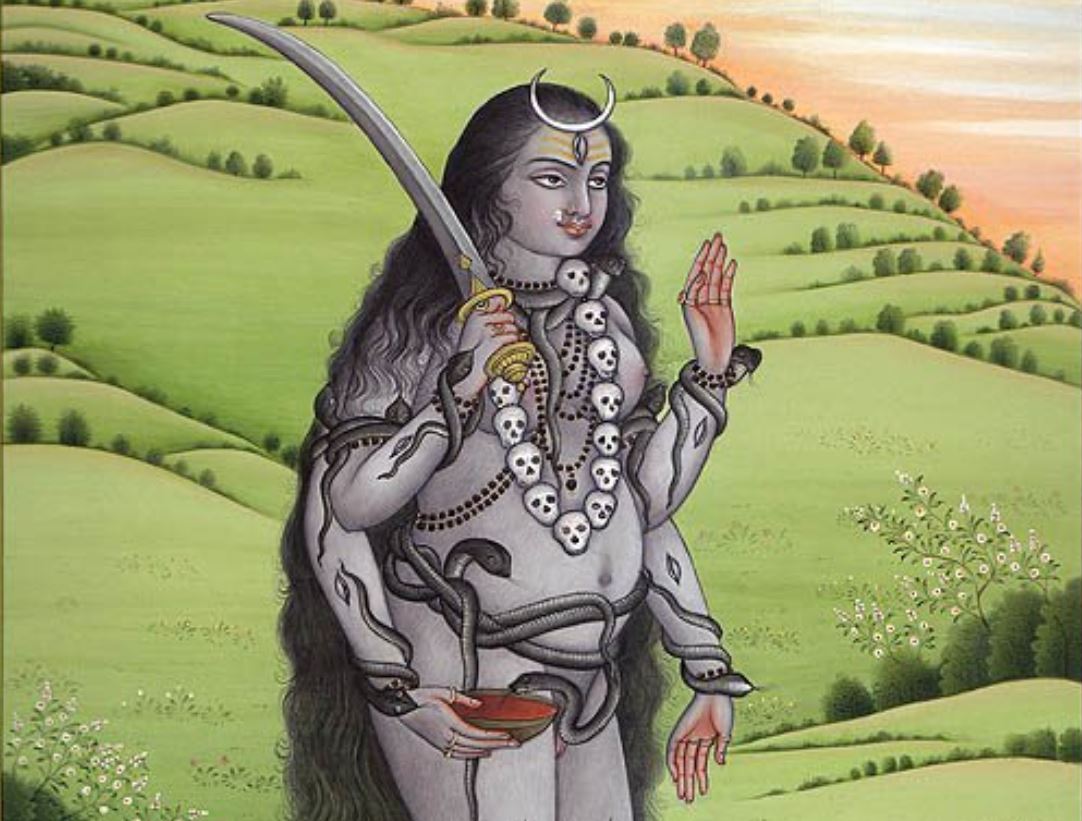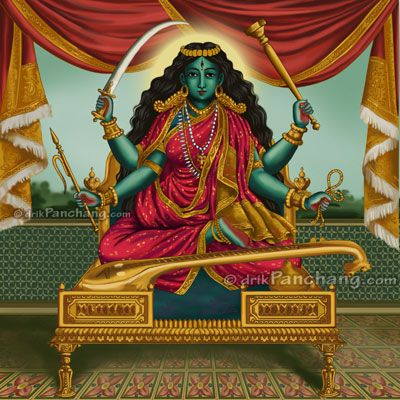- Thread: Dasha Mahavidya -
In traditional Shakta Tantra, one of the central themes are ten mahavidyas. It is the path of the knowledge of the self through adoration. The Goddess is seen as primordial energy that is in everything, and mahavidyas are manifestations.
In traditional Shakta Tantra, one of the central themes are ten mahavidyas. It is the path of the knowledge of the self through adoration. The Goddess is seen as primordial energy that is in everything, and mahavidyas are manifestations.
The purpose of thread is just to be educational for those interested in world religions & practices. If you want to learn more, I suggest book "Shakti Rising" ( https://www.amazon.com/Shakti-Rising-Embracing-Goddess-Wholeness/dp/1626259100). The thread will provide just basic information on each mahaviydas.
- Kali -
Kali is the first. She is representing time. Kali is the first because creation begins with time. Before time, there is just pure potential. As cosmos begins, so does linear time, and along with it, duality. Good and evil, light and dark - each exists in relation.
Kali is the first. She is representing time. Kali is the first because creation begins with time. Before time, there is just pure potential. As cosmos begins, so does linear time, and along with it, duality. Good and evil, light and dark - each exists in relation.
The manifest world then, strives only on the sequence of time phenomena. Nothing happens in vacuum & everything is connected with the previous moment in time. In the inner realm, the ego or "I" is created through time. As infant grows, they develop a sense of separate "I".
But as Tantra Shakta is usually non-dual, the Goddess is usually seen as both maya/illusion & freedom from it. There is simply nothing that is not the Goddess. And she who creates illusion of time & ego-identification, is also the path towards freedom from it.
She cuts the head of the "I"/ ego & dances on its corpse. As she is freedom & time, she offers the practitioner opportunity to step out of illusion any time, as every moment in time destroys the previous one. Therefore there is an opportunity to be reborn in "eternal now".
- Tara -
Tara's weapons symbolise destruction of ego & lotus unconditional protection. Her big belly represents hunger for selflessness. Tara symbolically represents vibration or throb. The first movement of creation is a sound or rhythm. She is the "Word" at the beginning.
Tara's weapons symbolise destruction of ego & lotus unconditional protection. Her big belly represents hunger for selflessness. Tara symbolically represents vibration or throb. The first movement of creation is a sound or rhythm. She is the "Word" at the beginning.
When a practitioner submits to the hum, sound of prayer, mantra, when the entire being is focused on it, the ego is lost. Tara is the primordial throb & vehicle towards higher existence, beyond attachment & ego.
- Tripurasundari -
Her name means "three beautiful cities" (tri - three, pura - cities, sundari - beautiful). She represents triads of existence. Mode of consciousness are tree - waking; dream state; sleep, action is triad of will, knowledge & action.
Her name means "three beautiful cities" (tri - three, pura - cities, sundari - beautiful). She represents triads of existence. Mode of consciousness are tree - waking; dream state; sleep, action is triad of will, knowledge & action.
In experience, there is a triad of experience itself, the experiencer & that which is experienced. She represents unity or oneness of all the triads. She is the both immanent & transcendent aspect of the Divine. She is the Divine both in manifestation & non-manifestation.
As Kaamakala she is embodiment of desire. Without Divine desire for self-manifestation, there is no the first sound/throb represented by Tara. Desire is how the Supreme manifests from Nothingness into Everythingness. This desire is root of all lifeform.
- Bhuvaneshwari -
In this manifestation, the goddess represents space. It is the act of the limitless Divine limiting itself in space. When the Divine turns towards manifestation in order to see Himself reflected in many form, is the function of Bhuvaneshwari.
In this manifestation, the goddess represents space. It is the act of the limitless Divine limiting itself in space. When the Divine turns towards manifestation in order to see Himself reflected in many form, is the function of Bhuvaneshwari.
- Bhairavi -
Bhairavi represents the Divine focus. When Divine desires to come manifest in forms, it comes as many specific, separate forms. When infinite Supreme Being takes finite forms is represented by this goddess.
Bhairavi represents the Divine focus. When Divine desires to come manifest in forms, it comes as many specific, separate forms. When infinite Supreme Being takes finite forms is represented by this goddess.
On an individual level, when trapped in separate ego, humans can be super focused on their own existence. She also symbolizes fear. It is believed that fear comes from illusion of separation, from lack awareness of the One, the indivisible whole.
- Dhumavati -
In her iconography she appears as an ugly, old woman. She looks scary and fearful. Symbolically, she represents the Non-Being before Being came into existence. She represents the sacred, primordial emptiness that was before everything.
In her iconography she appears as an ugly, old woman. She looks scary and fearful. Symbolically, she represents the Non-Being before Being came into existence. She represents the sacred, primordial emptiness that was before everything.
But as Tantra is non-dual & is not simply about transcending limitations but embracing & transforming them, Dhumavati represents both ignorance of darkness & the sacred darkness of Non-Being out of which creation arises.
- Chinnamasta -
Chinnamasta is fifth mahavidya (comes before Bhairavi & Dhumavati, I missed her out by accident). She is the goddess of very strong & fearsome iconography. Standing naked, with her two maidens, she removes her own head.
Chinnamasta is fifth mahavidya (comes before Bhairavi & Dhumavati, I missed her out by accident). She is the goddess of very strong & fearsome iconography. Standing naked, with her two maidens, she removes her own head.
Chinnamasta represents the coming together of light & sound to begin the process of creation. She is the movement from Non-Being towards Being. Chinnamasta is the one who brings macrocosmic energy into individual being. She brings it through brahmarandhra, the top of the head.
Through our individual self, humans believe themselves separate from God or Creator. Through her compassion, Chinnamasta beheads herself - cuts & destroys the very thing she created & allows for unity. All paradoxes, all dualities, all separation are reconciled in this unity.
- Baglamukhi -
Baglamukhi is shown as she snaps or hits the tongue of a demon. When identifying with ego, there is a lot of mental noise. We constantly think about future, past & are constantly engaged with our thoughts. Baglamukhi represents silence & emptiness of the mind.
Baglamukhi is shown as she snaps or hits the tongue of a demon. When identifying with ego, there is a lot of mental noise. We constantly think about future, past & are constantly engaged with our thoughts. Baglamukhi represents silence & emptiness of the mind.
- Matangi -
She is the goddess of leftovers, of impurities, of the rejected. The tribes who belonged to no caste would worship her. She accepts menstrual blood & many other impurities. She is believed to reside in the throat chakra & represents expression & speech.
She is the goddess of leftovers, of impurities, of the rejected. The tribes who belonged to no caste would worship her. She accepts menstrual blood & many other impurities. She is believed to reside in the throat chakra & represents expression & speech.
Esoterically, this is not any expression, she is dark because in order to find the formless, objectless truth one has to move towards mode of consciousness in which forms are blurred. As goddess of leftovers, she is the symbol of Divine that remains, after everything perishes.

 Read on Twitter
Read on Twitter






































